Reflective Analysis of the Internal Business Environment
VerifiedAdded on 2023/01/17
|9
|2624
|82
AI Summary
This report provides a reflective analysis of the internal business environment, focusing on the value chain model and its application in Starbucks. It discusses the advantages and challenges of the value chain model and its usefulness in understanding the internal business environment.
Contribute Materials
Your contribution can guide someone’s learning journey. Share your
documents today.
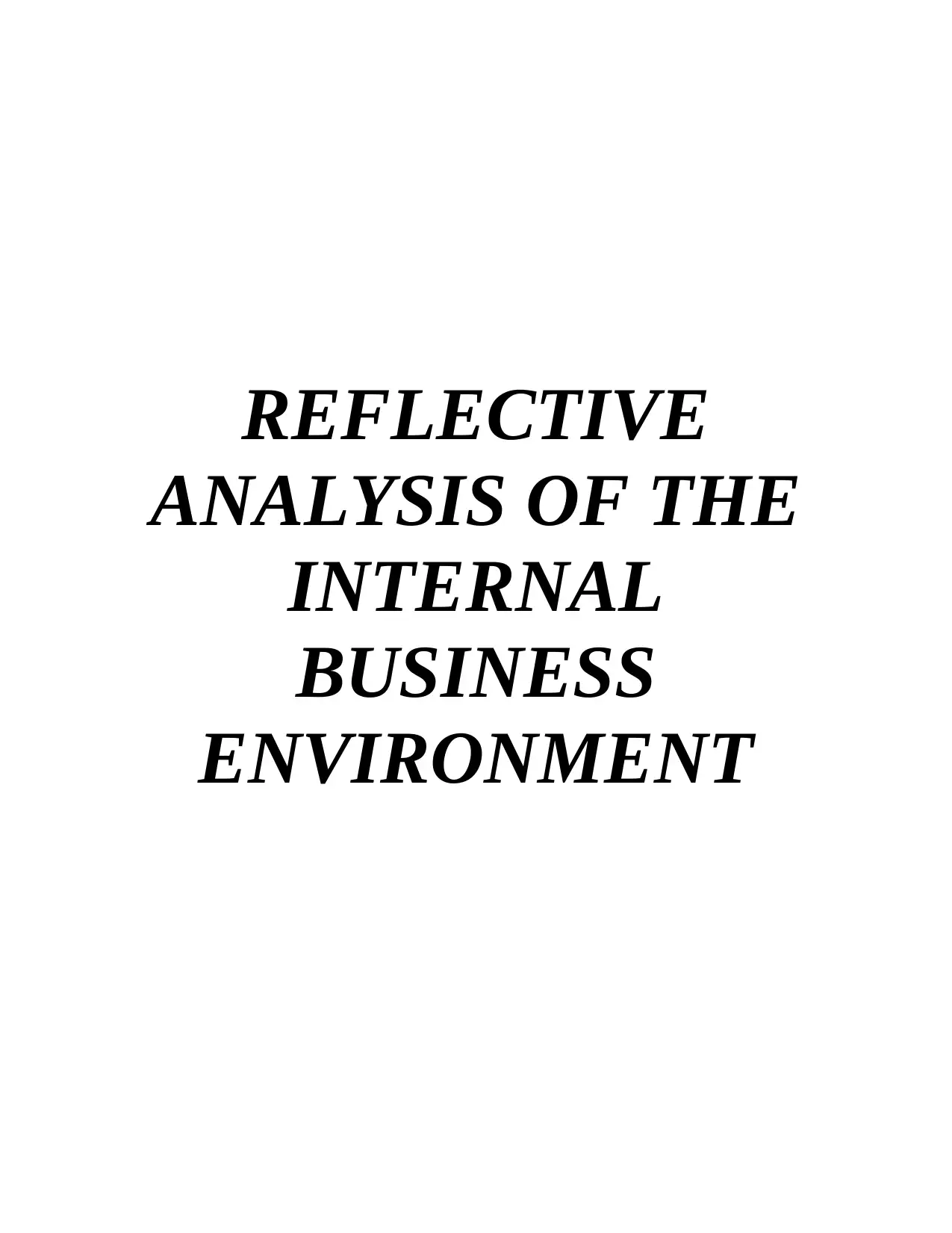
REFLECTIVE
ANALYSIS OF THE
INTERNAL
BUSINESS
ENVIRONMENT
ANALYSIS OF THE
INTERNAL
BUSINESS
ENVIRONMENT
Secure Best Marks with AI Grader
Need help grading? Try our AI Grader for instant feedback on your assignments.
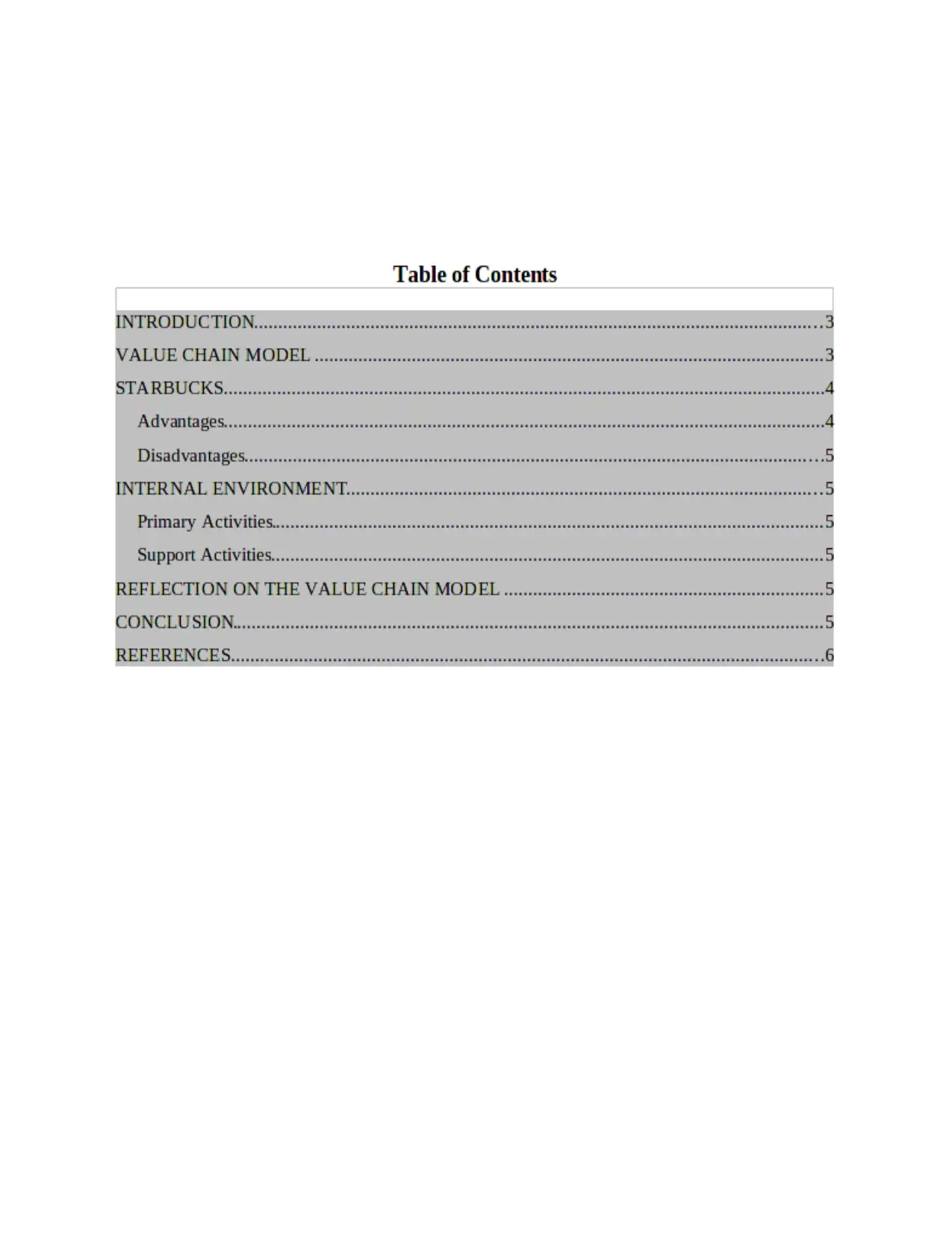
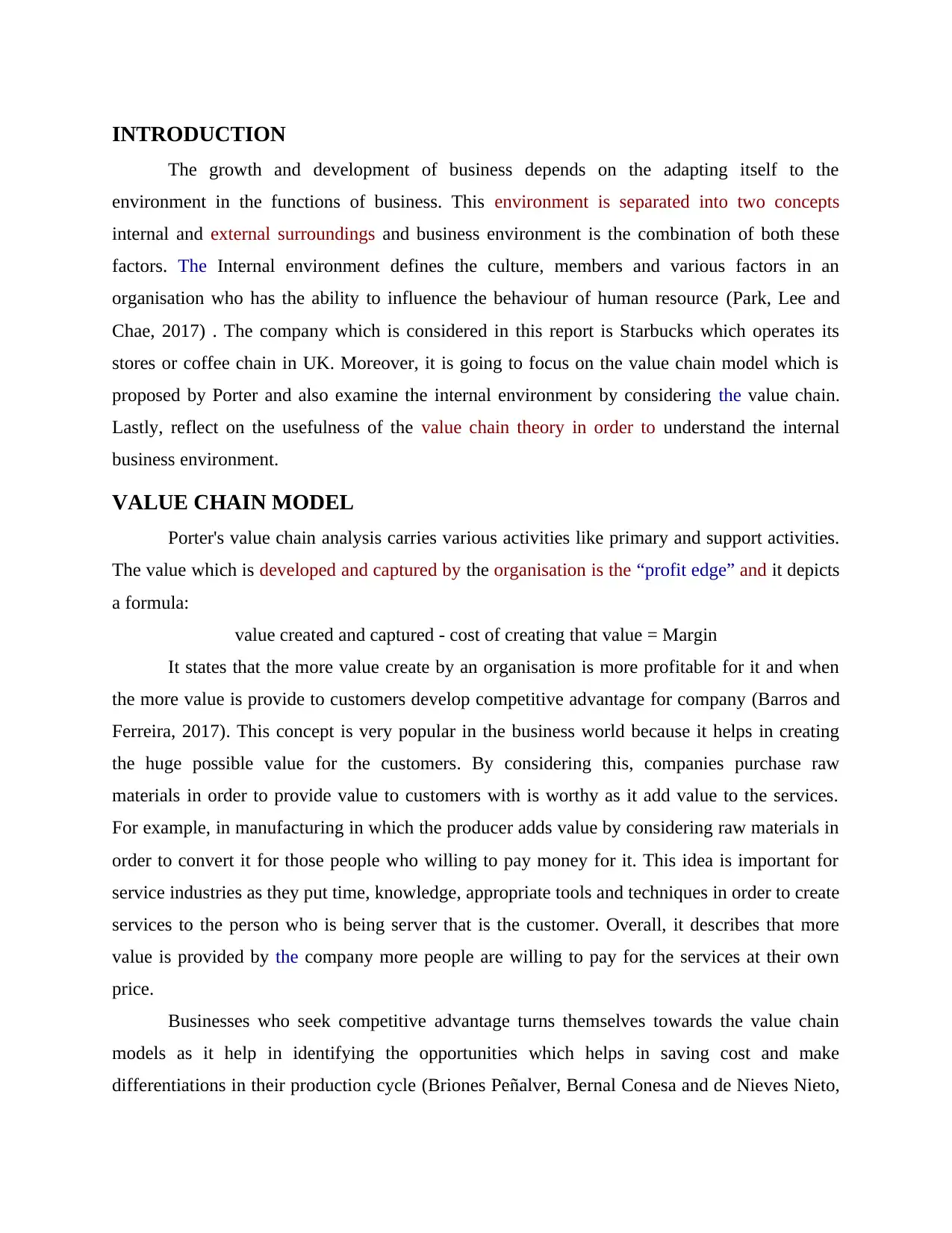
INTRODUCTION
The growth and development of business depends on the adapting itself to the
environment in the functions of business. This environment is separated into two concepts
internal and external surroundings and business environment is the combination of both these
factors. The Internal environment defines the culture, members and various factors in an
organisation who has the ability to influence the behaviour of human resource (Park, Lee and
Chae, 2017) . The company which is considered in this report is Starbucks which operates its
stores or coffee chain in UK. Moreover, it is going to focus on the value chain model which is
proposed by Porter and also examine the internal environment by considering the value chain.
Lastly, reflect on the usefulness of the value chain theory in order to understand the internal
business environment.
VALUE CHAIN MODEL
Porter's value chain analysis carries various activities like primary and support activities.
The value which is developed and captured by the organisation is the “profit edge” and it depicts
a formula:
value created and captured - cost of creating that value = Margin
It states that the more value create by an organisation is more profitable for it and when
the more value is provide to customers develop competitive advantage for company (Barros and
Ferreira, 2017). This concept is very popular in the business world because it helps in creating
the huge possible value for the customers. By considering this, companies purchase raw
materials in order to provide value to customers with is worthy as it add value to the services.
For example, in manufacturing in which the producer adds value by considering raw materials in
order to convert it for those people who willing to pay money for it. This idea is important for
service industries as they put time, knowledge, appropriate tools and techniques in order to create
services to the person who is being server that is the customer. Overall, it describes that more
value is provided by the company more people are willing to pay for the services at their own
price.
Businesses who seek competitive advantage turns themselves towards the value chain
models as it help in identifying the opportunities which helps in saving cost and make
differentiations in their production cycle (Briones Peñalver, Bernal Conesa and de Nieves Nieto,
The growth and development of business depends on the adapting itself to the
environment in the functions of business. This environment is separated into two concepts
internal and external surroundings and business environment is the combination of both these
factors. The Internal environment defines the culture, members and various factors in an
organisation who has the ability to influence the behaviour of human resource (Park, Lee and
Chae, 2017) . The company which is considered in this report is Starbucks which operates its
stores or coffee chain in UK. Moreover, it is going to focus on the value chain model which is
proposed by Porter and also examine the internal environment by considering the value chain.
Lastly, reflect on the usefulness of the value chain theory in order to understand the internal
business environment.
VALUE CHAIN MODEL
Porter's value chain analysis carries various activities like primary and support activities.
The value which is developed and captured by the organisation is the “profit edge” and it depicts
a formula:
value created and captured - cost of creating that value = Margin
It states that the more value create by an organisation is more profitable for it and when
the more value is provide to customers develop competitive advantage for company (Barros and
Ferreira, 2017). This concept is very popular in the business world because it helps in creating
the huge possible value for the customers. By considering this, companies purchase raw
materials in order to provide value to customers with is worthy as it add value to the services.
For example, in manufacturing in which the producer adds value by considering raw materials in
order to convert it for those people who willing to pay money for it. This idea is important for
service industries as they put time, knowledge, appropriate tools and techniques in order to create
services to the person who is being server that is the customer. Overall, it describes that more
value is provided by the company more people are willing to pay for the services at their own
price.
Businesses who seek competitive advantage turns themselves towards the value chain
models as it help in identifying the opportunities which helps in saving cost and make
differentiations in their production cycle (Briones Peñalver, Bernal Conesa and de Nieves Nieto,
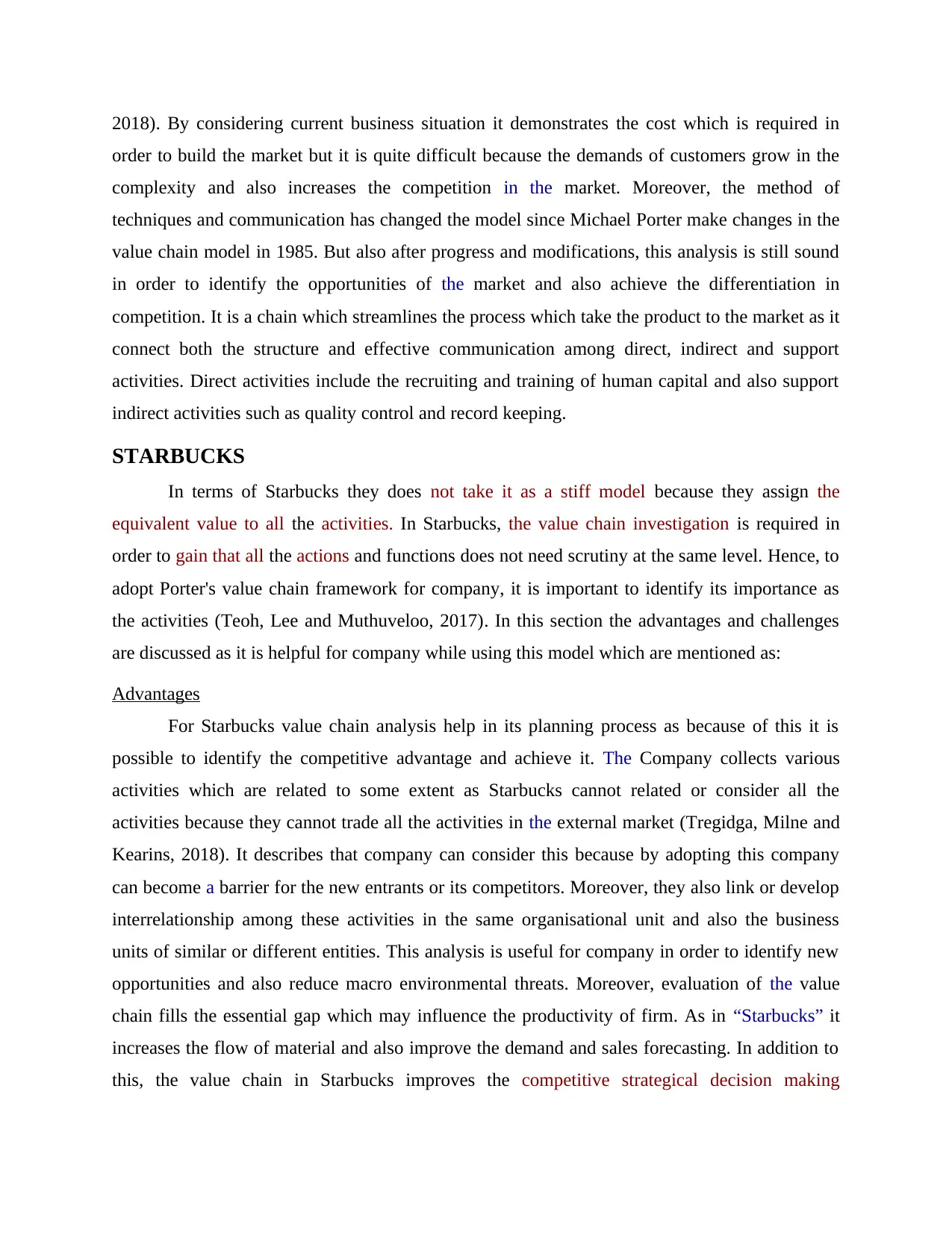
2018). By considering current business situation it demonstrates the cost which is required in
order to build the market but it is quite difficult because the demands of customers grow in the
complexity and also increases the competition in the market. Moreover, the method of
techniques and communication has changed the model since Michael Porter make changes in the
value chain model in 1985. But also after progress and modifications, this analysis is still sound
in order to identify the opportunities of the market and also achieve the differentiation in
competition. It is a chain which streamlines the process which take the product to the market as it
connect both the structure and effective communication among direct, indirect and support
activities. Direct activities include the recruiting and training of human capital and also support
indirect activities such as quality control and record keeping.
STARBUCKS
In terms of Starbucks they does not take it as a stiff model because they assign the
equivalent value to all the activities. In Starbucks, the value chain investigation is required in
order to gain that all the actions and functions does not need scrutiny at the same level. Hence, to
adopt Porter's value chain framework for company, it is important to identify its importance as
the activities (Teoh, Lee and Muthuveloo, 2017). In this section the advantages and challenges
are discussed as it is helpful for company while using this model which are mentioned as:
Advantages
For Starbucks value chain analysis help in its planning process as because of this it is
possible to identify the competitive advantage and achieve it. The Company collects various
activities which are related to some extent as Starbucks cannot related or consider all the
activities because they cannot trade all the activities in the external market (Tregidga, Milne and
Kearins, 2018). It describes that company can consider this because by adopting this company
can become a barrier for the new entrants or its competitors. Moreover, they also link or develop
interrelationship among these activities in the same organisational unit and also the business
units of similar or different entities. This analysis is useful for company in order to identify new
opportunities and also reduce macro environmental threats. Moreover, evaluation of the value
chain fills the essential gap which may influence the productivity of firm. As in “Starbucks” it
increases the flow of material and also improve the demand and sales forecasting. In addition to
this, the value chain in Starbucks improves the competitive strategical decision making
order to build the market but it is quite difficult because the demands of customers grow in the
complexity and also increases the competition in the market. Moreover, the method of
techniques and communication has changed the model since Michael Porter make changes in the
value chain model in 1985. But also after progress and modifications, this analysis is still sound
in order to identify the opportunities of the market and also achieve the differentiation in
competition. It is a chain which streamlines the process which take the product to the market as it
connect both the structure and effective communication among direct, indirect and support
activities. Direct activities include the recruiting and training of human capital and also support
indirect activities such as quality control and record keeping.
STARBUCKS
In terms of Starbucks they does not take it as a stiff model because they assign the
equivalent value to all the activities. In Starbucks, the value chain investigation is required in
order to gain that all the actions and functions does not need scrutiny at the same level. Hence, to
adopt Porter's value chain framework for company, it is important to identify its importance as
the activities (Teoh, Lee and Muthuveloo, 2017). In this section the advantages and challenges
are discussed as it is helpful for company while using this model which are mentioned as:
Advantages
For Starbucks value chain analysis help in its planning process as because of this it is
possible to identify the competitive advantage and achieve it. The Company collects various
activities which are related to some extent as Starbucks cannot related or consider all the
activities because they cannot trade all the activities in the external market (Tregidga, Milne and
Kearins, 2018). It describes that company can consider this because by adopting this company
can become a barrier for the new entrants or its competitors. Moreover, they also link or develop
interrelationship among these activities in the same organisational unit and also the business
units of similar or different entities. This analysis is useful for company in order to identify new
opportunities and also reduce macro environmental threats. Moreover, evaluation of the value
chain fills the essential gap which may influence the productivity of firm. As in “Starbucks” it
increases the flow of material and also improve the demand and sales forecasting. In addition to
this, the value chain in Starbucks improves the competitive strategical decision making
Secure Best Marks with AI Grader
Need help grading? Try our AI Grader for instant feedback on your assignments.
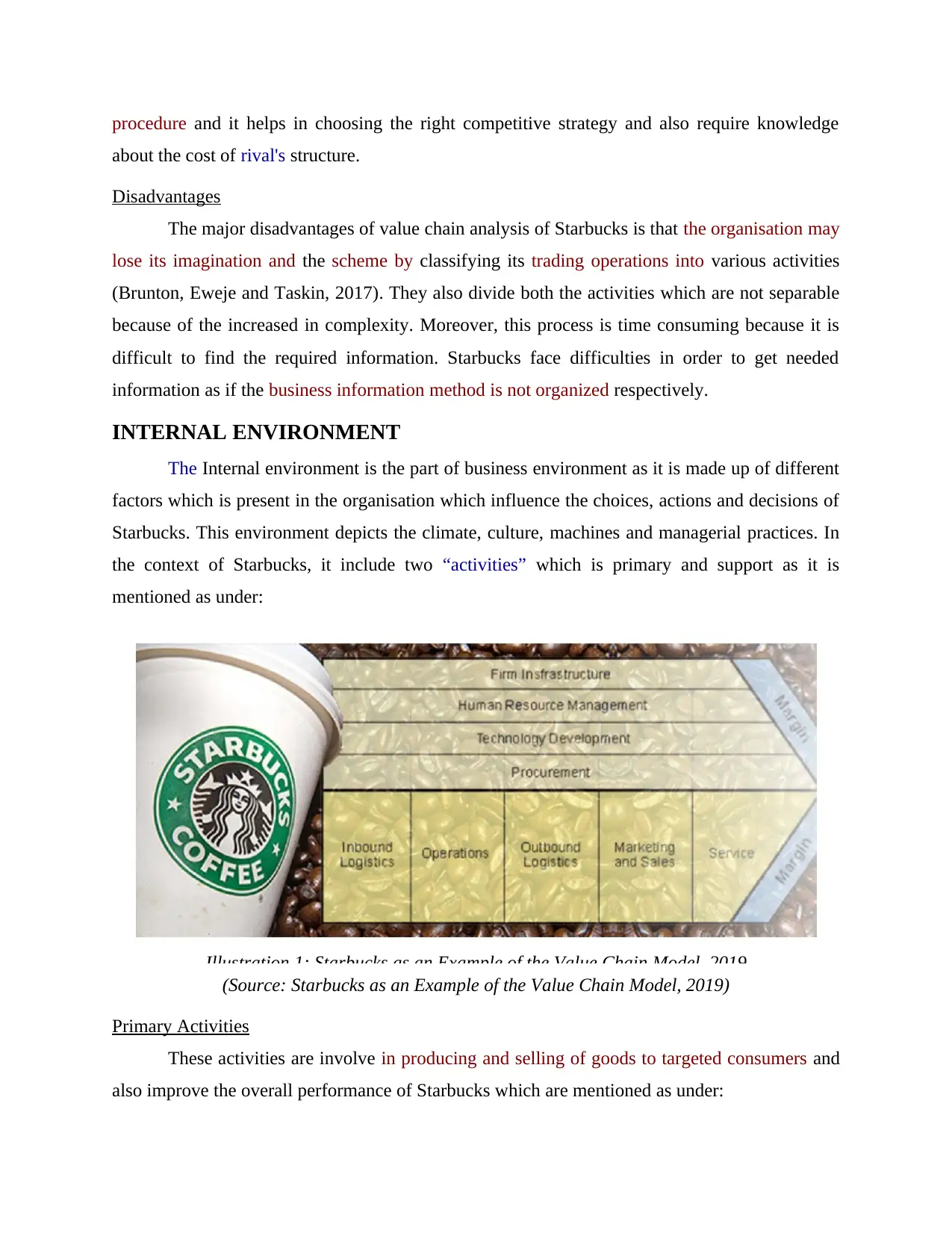
procedure and it helps in choosing the right competitive strategy and also require knowledge
about the cost of rival's structure.
Disadvantages
The major disadvantages of value chain analysis of Starbucks is that the organisation may
lose its imagination and the scheme by classifying its trading operations into various activities
(Brunton, Eweje and Taskin, 2017). They also divide both the activities which are not separable
because of the increased in complexity. Moreover, this process is time consuming because it is
difficult to find the required information. Starbucks face difficulties in order to get needed
information as if the business information method is not organized respectively.
INTERNAL ENVIRONMENT
The Internal environment is the part of business environment as it is made up of different
factors which is present in the organisation which influence the choices, actions and decisions of
Starbucks. This environment depicts the climate, culture, machines and managerial practices. In
the context of Starbucks, it include two “activities” which is primary and support as it is
mentioned as under:
(Source: Starbucks as an Example of the Value Chain Model, 2019)
Primary Activities
These activities are involve in producing and selling of goods to targeted consumers and
also improve the overall performance of Starbucks which are mentioned as under:
Illustration 1: Starbucks as an Example of the Value Chain Model, 2019
about the cost of rival's structure.
Disadvantages
The major disadvantages of value chain analysis of Starbucks is that the organisation may
lose its imagination and the scheme by classifying its trading operations into various activities
(Brunton, Eweje and Taskin, 2017). They also divide both the activities which are not separable
because of the increased in complexity. Moreover, this process is time consuming because it is
difficult to find the required information. Starbucks face difficulties in order to get needed
information as if the business information method is not organized respectively.
INTERNAL ENVIRONMENT
The Internal environment is the part of business environment as it is made up of different
factors which is present in the organisation which influence the choices, actions and decisions of
Starbucks. This environment depicts the climate, culture, machines and managerial practices. In
the context of Starbucks, it include two “activities” which is primary and support as it is
mentioned as under:
(Source: Starbucks as an Example of the Value Chain Model, 2019)
Primary Activities
These activities are involve in producing and selling of goods to targeted consumers and
also improve the overall performance of Starbucks which are mentioned as under:
Illustration 1: Starbucks as an Example of the Value Chain Model, 2019
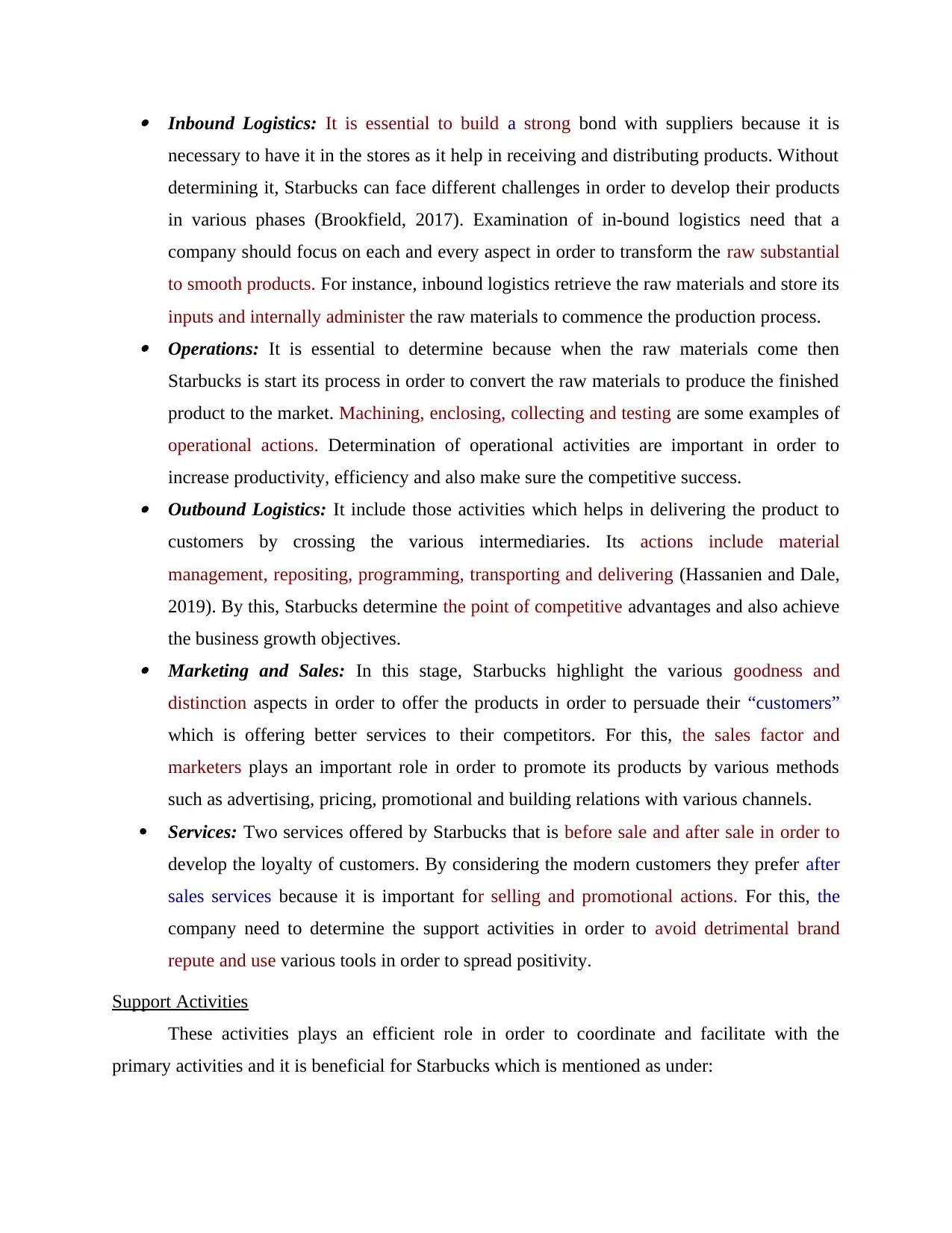
Inbound Logistics: It is essential to build a strong bond with suppliers because it is
necessary to have it in the stores as it help in receiving and distributing products. Without
determining it, Starbucks can face different challenges in order to develop their products
in various phases (Brookfield, 2017). Examination of in-bound logistics need that a
company should focus on each and every aspect in order to transform the raw substantial
to smooth products. For instance, inbound logistics retrieve the raw materials and store its
inputs and internally administer the raw materials to commence the production process. Operations: It is essential to determine because when the raw materials come then
Starbucks is start its process in order to convert the raw materials to produce the finished
product to the market. Machining, enclosing, collecting and testing are some examples of
operational actions. Determination of operational activities are important in order to
increase productivity, efficiency and also make sure the competitive success. Outbound Logistics: It include those activities which helps in delivering the product to
customers by crossing the various intermediaries. Its actions include material
management, repositing, programming, transporting and delivering (Hassanien and Dale,
2019). By this, Starbucks determine the point of competitive advantages and also achieve
the business growth objectives. Marketing and Sales: In this stage, Starbucks highlight the various goodness and
distinction aspects in order to offer the products in order to persuade their “customers”
which is offering better services to their competitors. For this, the sales factor and
marketers plays an important role in order to promote its products by various methods
such as advertising, pricing, promotional and building relations with various channels.
Services: Two services offered by Starbucks that is before sale and after sale in order to
develop the loyalty of customers. By considering the modern customers they prefer after
sales services because it is important for selling and promotional actions. For this, the
company need to determine the support activities in order to avoid detrimental brand
repute and use various tools in order to spread positivity.
Support Activities
These activities plays an efficient role in order to coordinate and facilitate with the
primary activities and it is beneficial for Starbucks which is mentioned as under:
necessary to have it in the stores as it help in receiving and distributing products. Without
determining it, Starbucks can face different challenges in order to develop their products
in various phases (Brookfield, 2017). Examination of in-bound logistics need that a
company should focus on each and every aspect in order to transform the raw substantial
to smooth products. For instance, inbound logistics retrieve the raw materials and store its
inputs and internally administer the raw materials to commence the production process. Operations: It is essential to determine because when the raw materials come then
Starbucks is start its process in order to convert the raw materials to produce the finished
product to the market. Machining, enclosing, collecting and testing are some examples of
operational actions. Determination of operational activities are important in order to
increase productivity, efficiency and also make sure the competitive success. Outbound Logistics: It include those activities which helps in delivering the product to
customers by crossing the various intermediaries. Its actions include material
management, repositing, programming, transporting and delivering (Hassanien and Dale,
2019). By this, Starbucks determine the point of competitive advantages and also achieve
the business growth objectives. Marketing and Sales: In this stage, Starbucks highlight the various goodness and
distinction aspects in order to offer the products in order to persuade their “customers”
which is offering better services to their competitors. For this, the sales factor and
marketers plays an important role in order to promote its products by various methods
such as advertising, pricing, promotional and building relations with various channels.
Services: Two services offered by Starbucks that is before sale and after sale in order to
develop the loyalty of customers. By considering the modern customers they prefer after
sales services because it is important for selling and promotional actions. For this, the
company need to determine the support activities in order to avoid detrimental brand
repute and use various tools in order to spread positivity.
Support Activities
These activities plays an efficient role in order to coordinate and facilitate with the
primary activities and it is beneficial for Starbucks which is mentioned as under:

Firm Infrastructure: It describes the range of activities like quality management,
handling legal structures, accounting, financing and many more. Excellent infrastructure
management allows the Starbucks to analyse the value of the entire value chain (Papadas
and et. al., 2019). For this, Starbucks control these activities in order to beef up the
competitory edge in the market. Human Resources Management: Starbucks determine its human resources by evaluating
various aspects of HR which include the recruiting, training, rewarding, performance
“management” and many more. Effective management allows Starbucks to reduce the
pressure which is based on the skills of workforce. The dependence of company on their
workers talent will improve its importance of the value chain support activities. Technology Development: The integrating of technology in manufacturing, delivery
process and human resource actions which are required by Starbucks in order to gain the
value of technology and its development. It include various departments such as
automation software, customer support service, designing of the product, research and
development and many more (Lindholm, Laine and Suomala, 2017).
Procurement: This process include the purchasing of inputs which ranges from
equipments, machinery, raw materials, supplies and other related items which are
important in order to produce the final products. Because of this linkage Starbucks
consider the procurement activities in order to optimise this valuable chain.
REFLECTION ON THE VALUE CHAIN MODEL
Value chain investigation is a technique which is useful in order to determine the internal
actions of the company. Its objective is to recognise the most precious state which becomes the
source for firm in order to differentiate its advantages as it help in order to supply the
competitive point. The entity which competes by the distinction advantage will always try to
execute its “actions” which is better than its competitors (Park, Lee and Chae, 2017). If the
company competes through cost advantages they will perform inside actions at low cost than
competitors. It describes the use of primary activities and also add the values in order to directly
conduct the production process as this activities are not more essential than assist activities. In
modern times, competitive edge depicts the improvements in technology or innovations in the
business model in order to process the performance. Hence, these support activities include the
information scheme and research and improvement or general administration which is the
handling legal structures, accounting, financing and many more. Excellent infrastructure
management allows the Starbucks to analyse the value of the entire value chain (Papadas
and et. al., 2019). For this, Starbucks control these activities in order to beef up the
competitory edge in the market. Human Resources Management: Starbucks determine its human resources by evaluating
various aspects of HR which include the recruiting, training, rewarding, performance
“management” and many more. Effective management allows Starbucks to reduce the
pressure which is based on the skills of workforce. The dependence of company on their
workers talent will improve its importance of the value chain support activities. Technology Development: The integrating of technology in manufacturing, delivery
process and human resource actions which are required by Starbucks in order to gain the
value of technology and its development. It include various departments such as
automation software, customer support service, designing of the product, research and
development and many more (Lindholm, Laine and Suomala, 2017).
Procurement: This process include the purchasing of inputs which ranges from
equipments, machinery, raw materials, supplies and other related items which are
important in order to produce the final products. Because of this linkage Starbucks
consider the procurement activities in order to optimise this valuable chain.
REFLECTION ON THE VALUE CHAIN MODEL
Value chain investigation is a technique which is useful in order to determine the internal
actions of the company. Its objective is to recognise the most precious state which becomes the
source for firm in order to differentiate its advantages as it help in order to supply the
competitive point. The entity which competes by the distinction advantage will always try to
execute its “actions” which is better than its competitors (Park, Lee and Chae, 2017). If the
company competes through cost advantages they will perform inside actions at low cost than
competitors. It describes the use of primary activities and also add the values in order to directly
conduct the production process as this activities are not more essential than assist activities. In
modern times, competitive edge depicts the improvements in technology or innovations in the
business model in order to process the performance. Hence, these support activities include the
information scheme and research and improvement or general administration which is the
Paraphrase This Document
Need a fresh take? Get an instant paraphrase of this document with our AI Paraphraser
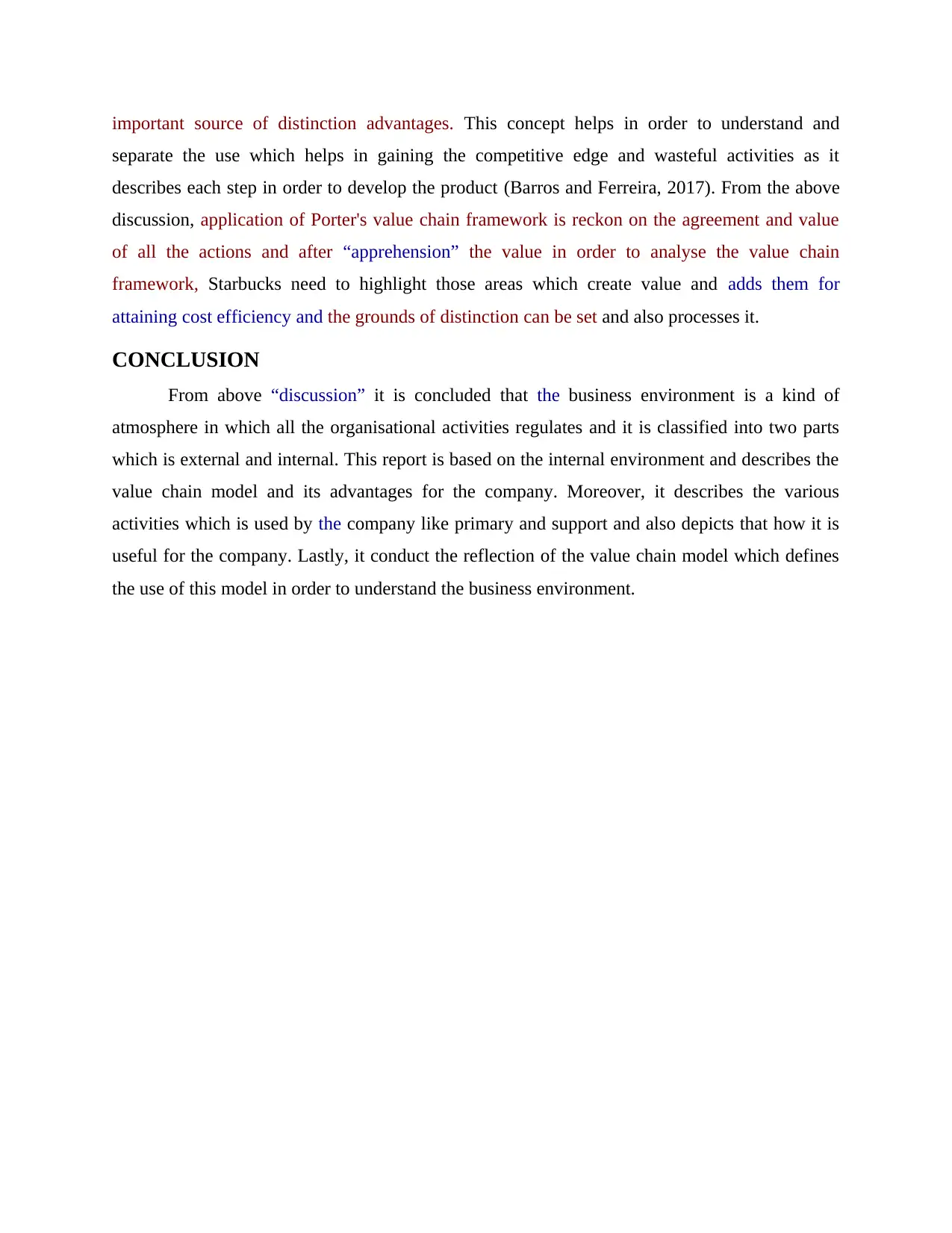
important source of distinction advantages. This concept helps in order to understand and
separate the use which helps in gaining the competitive edge and wasteful activities as it
describes each step in order to develop the product (Barros and Ferreira, 2017). From the above
discussion, application of Porter's value chain framework is reckon on the agreement and value
of all the actions and after “apprehension” the value in order to analyse the value chain
framework, Starbucks need to highlight those areas which create value and adds them for
attaining cost efficiency and the grounds of distinction can be set and also processes it.
CONCLUSION
From above “discussion” it is concluded that the business environment is a kind of
atmosphere in which all the organisational activities regulates and it is classified into two parts
which is external and internal. This report is based on the internal environment and describes the
value chain model and its advantages for the company. Moreover, it describes the various
activities which is used by the company like primary and support and also depicts that how it is
useful for the company. Lastly, it conduct the reflection of the value chain model which defines
the use of this model in order to understand the business environment.
separate the use which helps in gaining the competitive edge and wasteful activities as it
describes each step in order to develop the product (Barros and Ferreira, 2017). From the above
discussion, application of Porter's value chain framework is reckon on the agreement and value
of all the actions and after “apprehension” the value in order to analyse the value chain
framework, Starbucks need to highlight those areas which create value and adds them for
attaining cost efficiency and the grounds of distinction can be set and also processes it.
CONCLUSION
From above “discussion” it is concluded that the business environment is a kind of
atmosphere in which all the organisational activities regulates and it is classified into two parts
which is external and internal. This report is based on the internal environment and describes the
value chain model and its advantages for the company. Moreover, it describes the various
activities which is used by the company like primary and support and also depicts that how it is
useful for the company. Lastly, it conduct the reflection of the value chain model which defines
the use of this model in order to understand the business environment.
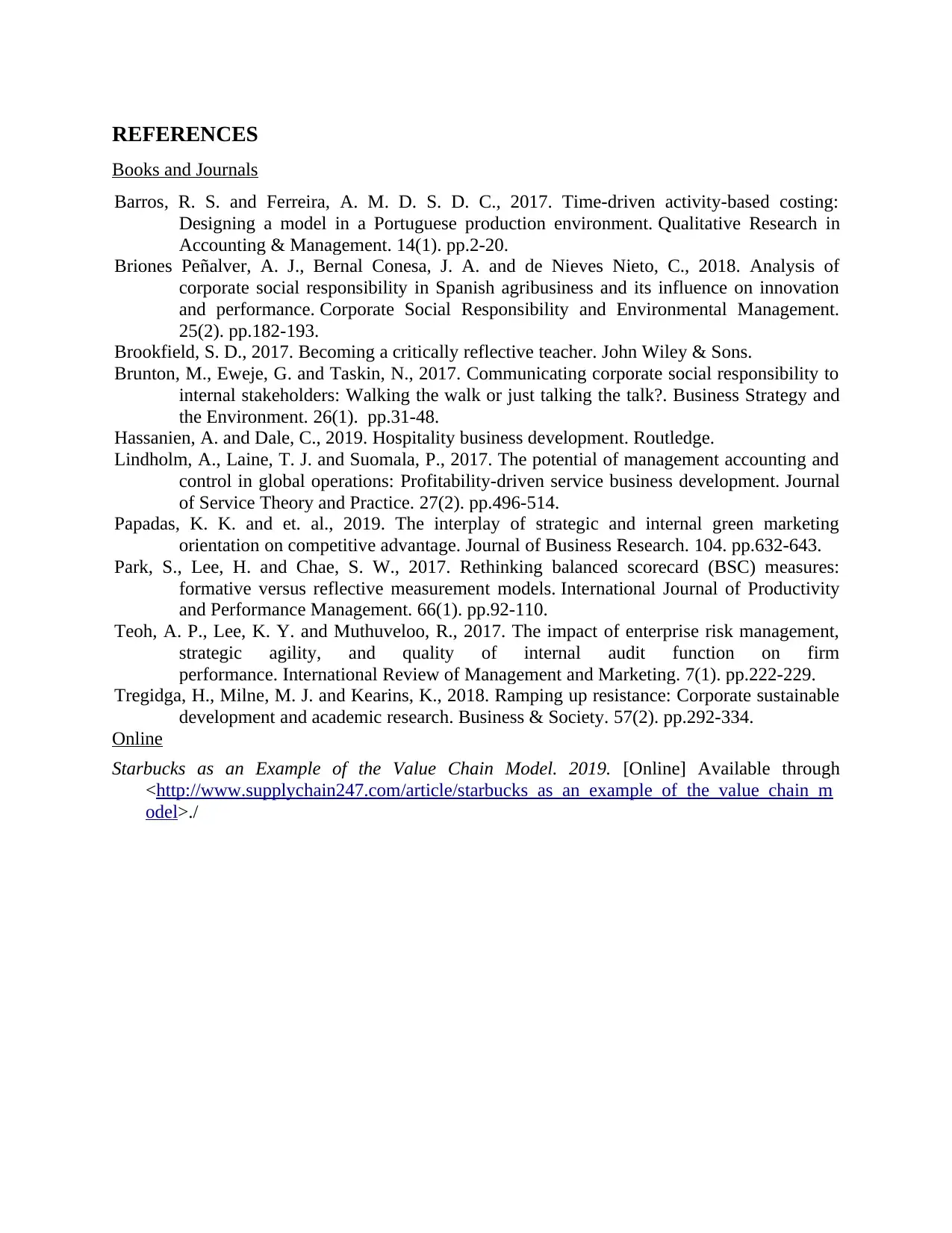
REFERENCES
Books and Journals
Barros, R. S. and Ferreira, A. M. D. S. D. C., 2017. Time-driven activity-based costing:
Designing a model in a Portuguese production environment. Qualitative Research in
Accounting & Management. 14(1). pp.2-20.
Briones Peñalver, A. J., Bernal Conesa, J. A. and de Nieves Nieto, C., 2018. Analysis of
corporate social responsibility in Spanish agribusiness and its influence on innovation
and performance. Corporate Social Responsibility and Environmental Management.
25(2). pp.182-193.
Brookfield, S. D., 2017. Becoming a critically reflective teacher. John Wiley & Sons.
Brunton, M., Eweje, G. and Taskin, N., 2017. Communicating corporate social responsibility to
internal stakeholders: Walking the walk or just talking the talk?. Business Strategy and
the Environment. 26(1). pp.31-48.
Hassanien, A. and Dale, C., 2019. Hospitality business development. Routledge.
Lindholm, A., Laine, T. J. and Suomala, P., 2017. The potential of management accounting and
control in global operations: Profitability-driven service business development. Journal
of Service Theory and Practice. 27(2). pp.496-514.
Papadas, K. K. and et. al., 2019. The interplay of strategic and internal green marketing
orientation on competitive advantage. Journal of Business Research. 104. pp.632-643.
Park, S., Lee, H. and Chae, S. W., 2017. Rethinking balanced scorecard (BSC) measures:
formative versus reflective measurement models. International Journal of Productivity
and Performance Management. 66(1). pp.92-110.
Teoh, A. P., Lee, K. Y. and Muthuveloo, R., 2017. The impact of enterprise risk management,
strategic agility, and quality of internal audit function on firm
performance. International Review of Management and Marketing. 7(1). pp.222-229.
Tregidga, H., Milne, M. J. and Kearins, K., 2018. Ramping up resistance: Corporate sustainable
development and academic research. Business & Society. 57(2). pp.292-334.
Online
Starbucks as an Example of the Value Chain Model. 2019. [Online] Available through
<http://www.supplychain247.com/article/starbucks_as_an_example_of_the_value_chain_m
odel>./
Books and Journals
Barros, R. S. and Ferreira, A. M. D. S. D. C., 2017. Time-driven activity-based costing:
Designing a model in a Portuguese production environment. Qualitative Research in
Accounting & Management. 14(1). pp.2-20.
Briones Peñalver, A. J., Bernal Conesa, J. A. and de Nieves Nieto, C., 2018. Analysis of
corporate social responsibility in Spanish agribusiness and its influence on innovation
and performance. Corporate Social Responsibility and Environmental Management.
25(2). pp.182-193.
Brookfield, S. D., 2017. Becoming a critically reflective teacher. John Wiley & Sons.
Brunton, M., Eweje, G. and Taskin, N., 2017. Communicating corporate social responsibility to
internal stakeholders: Walking the walk or just talking the talk?. Business Strategy and
the Environment. 26(1). pp.31-48.
Hassanien, A. and Dale, C., 2019. Hospitality business development. Routledge.
Lindholm, A., Laine, T. J. and Suomala, P., 2017. The potential of management accounting and
control in global operations: Profitability-driven service business development. Journal
of Service Theory and Practice. 27(2). pp.496-514.
Papadas, K. K. and et. al., 2019. The interplay of strategic and internal green marketing
orientation on competitive advantage. Journal of Business Research. 104. pp.632-643.
Park, S., Lee, H. and Chae, S. W., 2017. Rethinking balanced scorecard (BSC) measures:
formative versus reflective measurement models. International Journal of Productivity
and Performance Management. 66(1). pp.92-110.
Teoh, A. P., Lee, K. Y. and Muthuveloo, R., 2017. The impact of enterprise risk management,
strategic agility, and quality of internal audit function on firm
performance. International Review of Management and Marketing. 7(1). pp.222-229.
Tregidga, H., Milne, M. J. and Kearins, K., 2018. Ramping up resistance: Corporate sustainable
development and academic research. Business & Society. 57(2). pp.292-334.
Online
Starbucks as an Example of the Value Chain Model. 2019. [Online] Available through
<http://www.supplychain247.com/article/starbucks_as_an_example_of_the_value_chain_m
odel>./
1 out of 9
![[object Object]](/_next/static/media/star-bottom.7253800d.svg)





